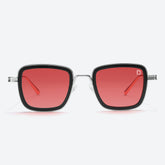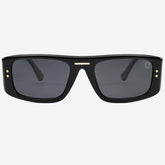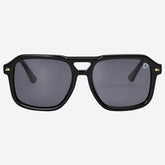Decoding Parts Of Sunglasses: How To Achieve Clear Vision And Comfort
Have you ever sat and tried to tackle the anatomy of your sunglasses? Of course, no. Why would you try learning the complex pieces of machinery? What if tell you how important it is for you to learn what the parts of sunglasses are called? You must go beyond the lens and frame. You cannot simply know these two words and expect to have a fine vision with a perfect fit. From the temples to the nose pad, every piece of glass is important in shaping our vision. In this read, understand and learn about the functions of essential accessory sunglasses parts name. This way you'd be able to fix minor problems without having to rely on professional help or needing to replace the sunglasses altogether
Why Is It Necessary To Learn The Sunglasses Parts Name?

Following are the reasons that make it necessary for you to know the parts of sunglasses.
1. Troubleshooting:
When you know the parts of sunglasses' names, things become simple. You easily locate the problem and understand why it is happening. For example, if your sunglasses keep slipping on your nose. You check the nose pads and adjust them for a better fit. Whether it is tightening or losing screws, adjusting the temple tips, or replacing missing nose pads. You save your time and money by avoiding unnecessary expenses of professional help.
2. Maintenance:
We all are aware that preventive care is effective maintenance. If you're dependent on your sunglasses and want their longevity. Maintenance becomes crucial. How is it possible for you to maintain something you have zero knowledge about? Regular inspection of frames, hinges, and temples prolongs the lifespan of your sunglasses. Different parts require different cleaning methods. Understanding these nuances helps you avoid damage in the maintenance process.
3. Communication:
Enhanced communication with eyewear consultants means accurate fixing. If you keep telling an optician my sunglasses are loose, it slips, this and that. He will have to spend more time identifying, locating, and diagnosing the problem. Instead, if you know the parts of sunglasses and their names. You will tell exactly where the problem is arising from. This will save you from potential delays or misunderstandings in fixing.
4. Safety:
What if you buy a pair not knowing whether it offers UV protection or not? The purpose of sunglasses nullifies. Exposure to UV rays will cause eye problems and your eye health will worsen over time. If you know certain parts of sunglasses, you'd know lenses are supposed to provide UV protection. Impact-resistant lenses save your eyes from accidental injuries. Safety becomes irresistible when you know what the parts of sunglasses are called.
5. Protection Against Frauds:
When you go to a sunglasses shop, your knowledge about glasses matters. Let's say you don't know the parts of sunglasses. The shopkeeper will easily hand you over the counterfeit products. These fake products tend to break easily. Whereas when you know parts of a sunglasses frame. It becomes easy to assess the price, genuineness of the frame, and false claims about the features and performance of your sunglasses.
Parts Of Sunglasses:

Each part of the sunglasses works in incorporation with the other. The malfunctioning of one piece disrupts the vision. Learning about the parts of sunglasses will solve half of your problem. If you know the parts, you're halfway there in solving. Let's find out the parts of sunglasses.
Glasses Anatomy Diagram:

See the parts of sunglasses. Look at all of these parts. Below we're going to study them individually and learn how each of them works.
1 Lens:

Lenses are customized according to your prescriptions. They refract light in a way that corrects your nearsightedness (myopia), farsightedness (hyperopia), or astigmatism.
Lens Types
Single Vision Lenses: Single lenses provide the same prescription power throughout the lens. It either treats nearsightedness, farsightedness, or astigmatism.
Progressive Lenses: Progressive vision lenses have multiple prescriptions throughout the lens. The upper part of the lens refracts light in a way that cures farsightedness. The lower part treats farsightedness. So you don't get to change lenses when inside reading or outside driving.
Coatings
The lens is the crucial part of sunglasses. It offers UV protection, anti-glare, and hydrophobic coatings. You can also get blue-light filtering coating, or light-responsive transition lenses according to your needs or the severity of your eye problem.
2 Frame:

The frame is the second most crucial part of sunglasses. It holds your lens in place. A frame is what ensures the fit and overall style/design of your sunglasses. It comes in various shapes, sizes, and colors. It is important because it provides functionality, durability, and aesthetics. Semi-rim or Rimless frames offer a sleek and lightweight look. Frames have many components that sit on your nose without sliding down or pinching. Let's discuss them below.
3 Bridges:

The bridge is the part of sunglasses that covers the span between the two lenses. It connects two rims by sitting on your nose. The bridge of the sunglasses ensures the weight of the frame, proper alignment, and comfort of the wearer. Proper fit of the bridge is ensured when it doesn't slide or pinch the nose. The visual appeal of the frame is enhanced by adding elements to these bridges.
Low bridge fit glass: For someone with prominent facial features such as high cheekbones. A low bridge-fit glass will work wonders.
High bridge fit glass: Wide faces should go for low bridges to enhance their features. There will be no discomfort or compromised vision.
4 Nose pads:

Nose pads provide stability and cushioning on the nose bridge. It prevents pressure points and the slipping of the frame. The comfort of the glasses is dependent upon the material of the nose pads. Hence they're made of soft material, either plastic or silicone. Rubber is also used. Nose pads are adjustable and they accommodate different types and sizes of noses. Tiny and cushioned nose pads allow airflow so there's no fogging up. They also balance the weight of the sunglasses evenly. Nose pads as a part of sunglasses are important in providing overall comfort and functionality.
5 Temple:

What secures and places the lens adequately? Temples. Temples or arms are part of sunglasses that are extended. These two long extensions sit on the ear. They secure the position of the lens. The customization of these temples is personal. You get the length of the temples according to your face shape and size. This ensures a proper fit for the wearer. Temples are attached via hinges which ensures folding. This means you can fold inward your glasses when they're not in use. If you measure the face and temple length initially. The sunglasses will ensure a smooth finish and comfortable fit without slipping or itching in everyday use.
6 Temple Tips:

Extended wear of sunglasses can cause pressure points. Temple tips are the ends of these two lengthy temples. These temple tips are parts of sunglasses that sit on your ear. They keep cushioning your ear so there's no discomfort during everyday use. These are also called earpieces. The metal temples have temple tips made of soft material. The use of soft and flexible material ensures no skin irritation. They also balance out the weight of the glasses. These earpieces reduce soreness or fatigue even after long hours of wearing sunglasses.
7 Screw:

Various components in sunglasses are secured together with fasteners. Screws are small metallic pieces in parts of sunglasses that hold everything together. These are in the hinges. The screwdriver present inside the tool kit for sunglasses tightens, loosens, as well as adjusts depending on your preference. Screws are very tiny yet they play a major role. They serve to maintain the structural integrity of frames and stability. Loose screw causes misalignment and disruption in visuals. This way, your eyesight worsens. So keep these screws fine between the two halves of the hinges. This will render you smooth opening and closing of temples!
8 Rim:

The rim is what holds the shape of the frame. The shape of your glasses and prescription lenses should be aligned. The rim is what decides whether the frame is oval, round, or square. The thickness, design, or style of the rim varies. But the function remains the same.
Full Rim: Full-rim encircles the complete lens. It provides maximum support and stability.
Semi-rim: Partial-rim offers half-rim. Which runs along the top of the lens. But it leaves the bottom of the lens exposed.
Rimless: Rimless frame means a subtle and sleek frame. In a rimless frame, the lenses are held with the screws or mounting hardware with no frames.
9 Rim Locks:

The minimalist and barely-there appearance of the frame is achieved with rim locks. Rim locks are screws or fasteners. These hold the lenses in place by attaching them to the frame's rim. This is one of the important parts of sunglasses.
10 Pad Arm:

Pad arm is one of the most important parts of sunglasses. It is very small but utterly significant. It is attached to rims which hold the nose pads in the right manner. This small and curvy part of sunglasses is there to hold the lens in its place. It accommodates and secures the nose pad. This ensures a perfect fit. Perfect fit as a result renders comfort and durability. Support and stability are its topmost priority. This proper alignment and positioning of the nose pad is impossible without the pad arm.
11 Top Bar:

The distinctive look of a frame is achieved through this top bar. What decides the type of glasses is this part of sunglasses. Whether the sunglasses are aviators or tortoiseshells, the top bar decides. The top bar is one of the parts of sunglasses that enhances the aesthetics of sunglasses. Besides enhancing aesthetics, this part of sunglasses is also responsible for adding structural stability. This is often reinforced to prevent distortion of lenses and provide additional comfort. This notable feature is responsible for functionality as well as stylishness. Let this top bar make your eyewear sturdy all along with elegance.
12 End piece:
End pieces are part of sunglasses that stand out. These are the outer corners of sunglasses. These are also called temple ends. They also play their part in securing comfort. They also have soft materials that prevent irritation, itching, or discomfort. The rivets or designs are also made on this part. So end pieces are responsible for giving your frame its stability and aesthetics.
13 Core Wire:

The durability and longevity of glasses are secured with the help of this component. Core wire is a part of sunglasses that ensures the structural support of your eyewear. It is made up of flexible material like metal or nylon. The core wire piece allows the temples to stay in place. It also connects the lenses. The glasses with exposed core wire inside metallic frames are surging into popularity. The exposed core wire grants a vintage touch to the frame. Along with that, it also prevents the warping or bending of the frame. Let the foundation of hinges and other components be secured by giving important attention to this part of the sunglasses.
Conclusion:
The key to having perfect and comfortable eyewear is knowledge of its anatomy. The parts of sunglasses might sound small and subtle. But from temples to nose pads and hinges to rivets, each plays a significant part. They interlink and give you a frame with a prolonged lifespan. The longevity of your frame is in its authenticity and maintenance. Knowing the parts of the sunglasses name helps you solve minor issues. Optimize your eyewear experience by making informed choices. After all, you deserve clear vision and eye safety for the years to come!





